Gastronomy and Culinary travel info for Peru
For hours of education online, we recommend the below websites:- http://www.theperuguide.com/gastronomy/peruvian-cuisine-glossary.html
- http://www.livinginperu.com/gastronomy/categories-recipes
- http://en.wikipedia.org/wiki/Peruvian_cuisine
- http://perufood.blogspot.com/
- http://www.perumuchogusto.com/
- http://www.yanuq.com/english/
- http://enperublog.com/2009/03/10/eating-in-lima-what-not-to-miss-afro-peruvian/
- http://www.theperuguide.com/gastronomy.html
- http://www.livinginperu.com/gastronomy/glosary
- http://www.limaeasy.com/peruvian_food/peruvian_food_cuisine_overview.php
- Video of Peruvian Cuisine from PromPeru:

PERU’S FOOD IN THE NEWS
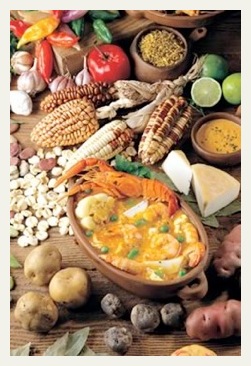
The "booming" Peruvian cuisine began the conquer Europe through Madrid, the Spanish daily El Pais stated today in a report on renowned chef and businessman Gaston Acurio and the varied cuisine of Peru . The newspaper report entitled “Bistrot a la peruana” (Peruvian Bistrot) mentions the opening of a new Gaston Acurio's restaurant in Madrid, and stresses that Peruvian cuisine combines Inca influences with Spanish, African, Chinese, Japanese and Italian-inspired dishes.
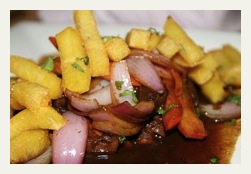
It also highlights its long list of tasty dishes characterized by its generous portions. That experience will be precisely enjoyed at Acurio’s Tanta restaurant, including traditional dishes such as causa, yuca a la huancaina, cebiche, tiradito, anticucho, lomo saltado, aji de gallina, pollo nikkei, and spaghetti al rocoto, the daily reported. Tanta (bread in Quechua) offers a set menu of between 25 - 35 Euros and what the writer (Mario) Vargas Llosa called "one of the most inventive and refined cuisine in the world."
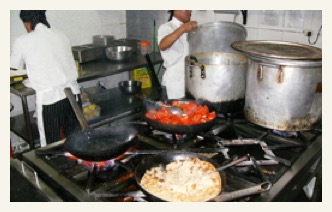
By Dan Collyns
BBC News, Lima
Food cuts across all social, racial and geographical barriers. Rich or poor, Peruvians pride themselves on eating well. Fast food is frowned upon and a poorly-prepared platter is seldom tolerated. Strange in a country where a quarter of children still suffer from malnutrition but Peru's sharp inequality is one of its many paradoxes. It is one of the 10 countries in the world classed as 'mega-diverse' in terms of its biodiversity, which means in nutritional terms it is rich beyond measure.
The Andes holds dozens of unique grains, roots and vegetables. It is the birthplace of the potato, with around 3,000 varieties.
The Peruvian Amazon is sparsely populated but a whole new world of flora and fauna. You can find caiman (a type of crocodile) on the menu here and an enormous freshwater fish, the paiche. Plaintains, peccaries (a type of wild pig) and dozens of unusual fruits make up the cuisine. Peru's coast has probably the richest fishing grounds in the world thanks to the cold water Humboldt Current which sweeps up the western side of South America from Antarctica.
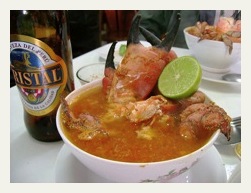
Ceviche is Peru's flagship dish. It is Peru's flagship dish of raw fish marinated with Peruvian limes and chillies - ceviche - which will "make the world discover the other Peruvian dishes, just as the Italians did with pasta and pizza and the Japanese did with sushi", says Mr Acurio. "We are going to start telling our story with ceviche. It's a story of conquest," he explains."Our story is one of a third world country. For the first time a Peruvian invention - our food - is seducing the world, so that's like liberation for us." For Mr Acurio, Peruvian food reflects a perfect blend of all its cultures and races, added to over time by waves of immigration. "Like an orchestra with a lot of instruments, all our bloods are like a perfect melody," he says.
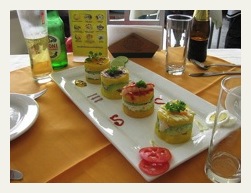
Food celebrated La Mistura, or the mixture, is a gastronomic festival organised by the Peruvian Gastronomic Society, or Apega, of which he is president. Hosted in Lima's Parque de Exposicion, or Exhibition Park, it has dozens of food outlets and aims to play host to 200,000 people over four days. The event began with a speech by Peru's president, Alan Garcia, who spoke of Peruvians' self-esteem and pride in their national cuisine. A confidence boost for a nation which won't qualify for the 2010 Football World Cup.
The government has passed a decree declaring that food is part of the nation's heritage and contributes to the "consolidation of national identity". And that identification seems to be a tangible economic force as the restaurant sector is still growing despite the global financial crisis.
"Peruvian cooking is terrific, it's now just a question of doing what the Japanese have done," says Hernando de Soto, a Peruvian economist and author. "It's not just a question of the quality. It's a question of how you patent it, brand it, capitalise it and finance it."
Creating opportunities. Chef schools are opening up across the country, with more than 6,000 students now studying haute cuisine but with Peruvian ingredients.
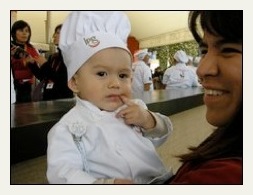
To be a chef also means creating opportunities for those who don't have them in Peru, says Gaston Acurio. As the gastronomy business grows so, in turn, will the demand for quality Peruvian produce, be it coffee, red onions or native potatoes, bought for a fair price from a small farmer. "Food must be a space to break down the barriers and prejudices in our country," explains Mr Acurio.
"If we can be a vehicle for that then our work is justified. We should because food and hunger are not compatible. "As Peruvian cooks we need to be proud not only of our food but to be proud of what we build in our country too."
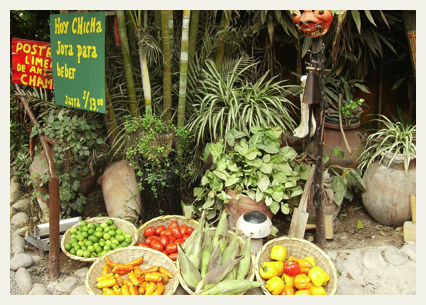
HOW TO: Grab a Cusqueña and get comfortable. As Nicholas Gill explains, a trip to a Peruvian cevichería can be an all-day immersion in good conversation and raw seafood.
The situation: It’s Sunday, and after a night out in Lima, Peru, you’ve found yourself in a cevichería. It’s more, you discover, than a mere place to order ceviche. It’s a cultural institution where lime juice abounds, and the events and misadventures from the previous night are discussed, reenacted and celebrated. Here’s your primer.
When to go: While most cevicherías are open daily, Sunday is traditionally their busiest day and visiting one is a weekly ritual for many Limeños. After partying until dawn the night before in Lima’s discos, you might rest for a few hours but still feel like the bottom of your shoe. The act of going to a cevichería is something that can both refresh and revive; a combination of hair of the dog and raw seafood. The experience begins in the late morning and typically lasts all day; the overindulgence may, on a good day, eclipse that of the night before.
The basics: Early, crude forms of ceviche began to appear in pre-Colombian times in the coastal civilizations of South America where fish was “cooked” with a fruit called tumbo. Later the Incas ate salted fish marinated in chicha, a fermented corn drink, and when the Spanish arrived, they added limes and onions to the mix.
Ceviche preparations vary from place to place—in Mexico, finely diced fish in lemon juice is served with crackers and Tabasco; in Ecuador, ceviche includes tomatoes and is much soupier; in the Andes, chefs use trout—but it’s the Peruvian version that’s recently caught on outside Latin America.
In Peru, ceviche is eaten as a first course or appetizer. The dish requires fresh, quality ingredients; precise and lightning-fast execution; and a basic understanding of spices and acidity. The chef tosses fresh chunks of any firm white fish, such as flounder or sea bass, with onions, bits of Peruvian ají peppers, seasoning and—most importantly—lime juice only minutes before serving. Ceviche isn’t exactly raw like sashimi is raw, though. The acid in the lime actually cooks the fish just before you eat it, resulting in an explosion of taste and texture. In the same dish you’ll find a slice of sweet potato, a few sticks of boiled yucca and a small piece of corn on the cob.
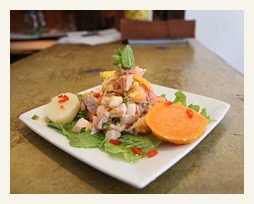
Where to go: Pick up Lima’s restaurant guide, “Guia Gastronomica,” for suggestions, or head to the seaside districts of Barranco and Chorrillos, and look for the crowds spilling into the street from restaurants like Punta Arenas or La Canta Rana. For a step up in price and quality, check out dining options in the Miraflores district such as Caplina or the trendster hot spot La Mar, owned by Lima’s outspoken TV chef Gastón Acurio. At either you’ll find local celebrities and wealthy Limeños sipping on pisco-infused cocktails and noshing on Novo Andino (New Andean) foods, including a lineup of ceviches and tiraditos.
Still, the best cevicherías are a bit out of the way. Sonia, a ceviche shack near the Chorrillos fish market that has grown a fanatic following, is tucked away in a far corner of the city. Sankuay, aka Chez Wong, sits in an unpretentious part of Lima, but the loyal ensemble of BMWs and Mercedes outside give it away as a culinary gem. Inside, chef Javier Wong takes a look at you and decides what you are going to eat. If you don’t like it, then leave.
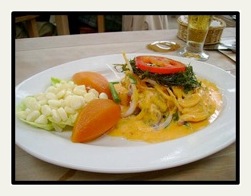
Next, move on to the goods: ceviche or tiradito. Ceviche comes in many forms: clásico (the traditional mix), mixto (with fish, squid, octopus and scallops), camarón (with crayfish), black conch (said to increase your sexual prowess), pato (with duck), and champiñones (with mushrooms). Tiradito is the modish, young cousin of ceviche. Created by Nikkei (Japanese) chefs in Lima, it relies on the tradition of dousing raw fish in lime juice, but the slices are paper thin and its makers add a spicy ají-based sauce.
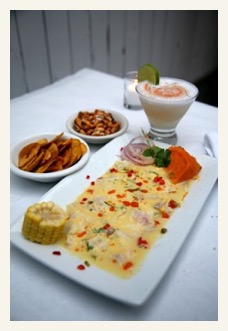
Bask in the benefits: Die-hard connoisseurs will try to sell you the health attributes of ceviche like a can of snake oil—it will prevent sleepwalking, cure a hangover, and even increase your sex drive. While there may be some truth to their words, a visit to a cevicheria will at the very least guarantee good times and a full belly. Buon Provecho!
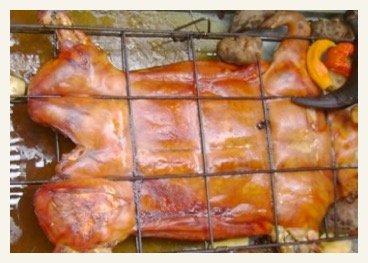
"Half of the population think cuisine is what best represents Peruvian culture to the outside world. It's not just eating well, we have a brand that differentiates us from others," Apega’s President Bernardo Roca Rey said. In fact, more than one third of our household budget is spent on food, which includes frequent trips to rotisserie chicken restaurants (pollerias), seafood restaurants or Chinese Peruvian restaurants (chifas) among the wide variety offered by nearly 70000 restaurants across the country.
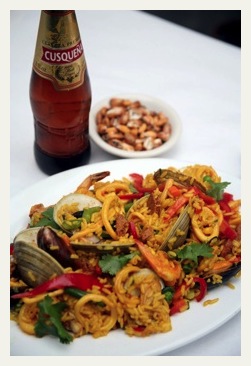
Click below for suggested travel itineraries & information:
Lima Food Tours
Cuzco Food Tours
You are welcome to call us anytime at 1-239-992-9660, or toll free at 800-446-9660 or email us at travel@GoExploring.com
The Great Variety of Peruvian Snacks
(from www.limaeasy.com)
In general Peruvians love to snack! You can buy small plastic bags filled with all sorts of goodies from streets vendors around every corner, a habit many Peruvians can't break with when wandering around town, waiting for or traveling in the bus or to keep their children quiet. On markets, in bodegas and supermarkets you find a great variety of snacks. So the choice might be difficult. In rustic restaurants Peruvian bread rolls or snacks are served as a small welcome starter, in bars to accompany a Pisco Sour or beer. At home many Peruvians love to have different varieties of (hot) chips with spicy salsas. Mostly typical Peruvian noshes are around for centuries and use local ingredients like corn varieties, potatoes, beans, bananas or dried fruits.
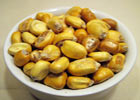
Cancha Salada - Roasted Salted Corn
Cancha Salada is a popular snack in Peru already consumed by ancient cultures. Maiz cancha, a special corn variety, is roasted in some oil and then salted to get a delicious nosh that can be bought on the street or is served in some restaurants as welcome.
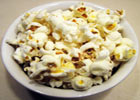
Canchita (Palomitas) - Popcorn
Like everywhere in the world, popcorn is mostly fancied by children. In Peru there are numerous "popcorn" varieties. It's not only made from the usual popping corn, but also from large kernels corns, Kiwicha or quinoa giving the good old popcorn a completely new, but interesting and very tasty touch.
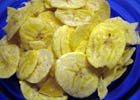
Chifle - Banana Chips
Popular around the country, chifle can be bought with street vendors, at kiosks, bodegas, on the market or supermarket. Finely sliced green or ripe bananas are fried in oil and then seasoned with salt. Depending on the banana variety and the maturing of the banana the taste can be sweeter or more savory.
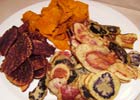
Chips Andinas (Chips Nativas) - Chips made from native Andean potatoes
A few years back the Peruvian International Potato Center had the idea to promote native potatoes by using them to make colorful chips. At the same time this endeavor had a good side effect: providing a new income source for local agricultural communities in the Peruvian high Andes. Equally important, this project preserves part of the Peruvian biodiversity and culture. Once in the shelves of big supermarket chains in Lima and other Peruvian cities, chips made of Papas Nativas, Papas Andinas or even Camote soon gained enormous popularity among local shoppers and today are even exported.
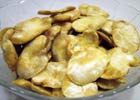
Habas Saladas - Salted Broad Beans
Habas Saladas are a well-liked snack in Peru. Broad Beans are fried in a little bit of oil, causing the skin to split open. After removing the skins from the pan, they are salted and/or spiced with aji to produce a savory crunchy snack.
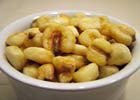
Maiz Cusco - Salted White Corn variety
Maiz Cusco is a corn variety also called "giant corn mote of Cusco". The large size corn kernels are fried in oil and salted to get a tasty snack that is popular in the country.
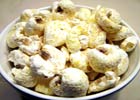
Maná confitado - Popped Corn Variety
Maná is produced of large sized corn kernels that are popped like "normal" popcorn and then infused in sugar. The result is delicious, sweet and crunchy popcorn with a unique flavor.
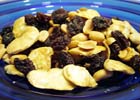
Mixtura Snack - Snack Mixture
Wildly well liked in Peru are so called Mixtura Snacks, mixtures with changing local ingredients similar to "nuts and raisins". Depending on the ingredients available, Peruvian pasas (raisins), manis (peanuts), Nueces de Brasil (brazil nuts), habas saladas (salted broad beans), roasted corn varieties, Chifle (banana chips) or potato chips are used to make great tasting noshes.
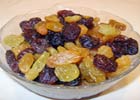
Pasa Morena o Pasa Rubia - Raisin
Peru is well respected worldwide for its grapes. No wonder that Pasas or raisins are very popular in the country. Mostly consumed are Pasas Morenas, raisins made of black grapes, and Pasas Rubias, a sultana variety.
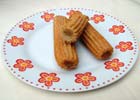
Churros
Churros are not, like quite often stated, a donut-like Peruvian treat. Originating in Spain Churros are long sticks made of a choux pastry often potato based which is squeezed through a large star tip into hot oil and fried. In Peru they are often filled with Manjarblanco or vanilla cream and then rolled in a sugar cinnamon mixture. While you can order them as dessert in many restaurants, Churros are best enjoyed bought from a street vendor and eaten warm. Absolutely delicious!
Typical Peruvian Starters & Appetizers
(from www.limaeasy.com)
A starter is a good way to introduce you to a great Peruvian meal. Unheard of in Peru until the 17th century most Peruvian starters today often replace a full meal or are also eaten as a small lunch or snack. Below find some appetizers characteristic for the art of cooking in Lima and on the central coast of Peru.
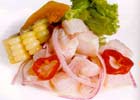
Ceviche (Cebiche) - Peru's National Dishx
The Peruvian national dish is like no other one reflecting the coastal cuisine and its influences. Ceviche is the most popular dish in Peru and the pride of all Peruvians. While there are hundreds of variations the basic Ceviche is made of fresh, raw, white fish filet cut into bite-size pieces, marinated and “cooked” in lime juice and seasoned with Peruvian chili peppers, onions and salt. Ceviche is often served with boiled sweet potatoes (camote), cooked corn (choclo), toasted corn (cancha) and raw onions.
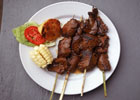
Anticuchos - Grilled Meat Skewers
Anticuchos are skewers consisting of small pieces of grilled meat that are marinated in lime juice, vinegar and spices like aji (Peruvian chili peppers), cumin and pepper. The most traditional and for locals most popular Anticuchos are made of beef heart (Anticuchos de Corazon), but often chicken, beef and fish is used to prepared delicious Anticuchos.
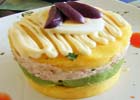
Causa Limeña
Without the traditional Causa, summer in Lima is not the same. For Limeños there is no other food on a hot summer day more popular and refreshing than Causa. While there are hundreds of variations the traditional Causa Limeña is made of layers of cooked, mashed yellow potatoes filled with a variety of vegetables (avocado, onions, choclo and chili) and fish (tuna, shellfish) or chicken. Causa is usually served cold garnished with black olives, hardboiled egg and probably some shrimps.
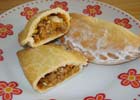
Empanadas
Peruvian empanadas (a stuffed pastry) are mostly filled with fried ground beef, onions, olives, hard-boiled egg and raisins. After baking the empanadas are sprinkled with icing sugar and before eating with a little bit of lime juice. In recent years numerous variations became very popular: empanadas with chicken, cheese, ham and cheese, lomo saltado or aji de gallina.
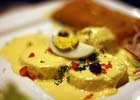
Papas a la Huancaina - Potatoes Huancaina style
Even if the name says this dish is from Huancayo, it was actually invented in Chosica, Lima, but by a señora from Huancayo. The dish consists of boiled and sliced yellow potatoes with a spicy sauce made of fresh white cheese, yellow Peruvian pepper (aji amarillo), milk, oil and salt. Papas a la Huancaina are served cold with a garnish of black olives, hardboiled egg and cooked corn (choclo).
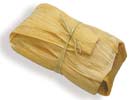
Tamales
Tamales are a very traditional Latin American dish. They are made of starchy dough, often corn- or potatoes based, to which meats (pork or chicken), cheese, chilies, vegetables, garlic and other spices are added. This mixture is wrapped in banana leafs, properly tied and cooked in boiling water.
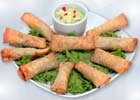
Tequeños
Tequeños are known in all Latin America. In Peru they are very popular as starter or small snack in the evening at a bar accompanying a Pisco or beer. Traditionally only made with a Won Ton wrap like dough filled with white cheese (Queso Fresco), in Lima you find numerous variations. Try the cheese and ham filling, the lomo saltado or aji de gallina filling. Yummy!
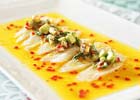
Tiradito
Some say Tiradito is just Ceviche without onions. Both dishes are made of raw white fish, but for Tiradito the fish is cut into sashimi-style thin stripes instead of cubes. While the fresh fish in a ceviche is marinated in a spicy lime juice sauce, in Tiradito it’s just covered with a piquant lime juice dressing and then immediately served. Popular variations of Tiradito combine the lime juice dressing with aji or rocoto creme. Often boiled sweet potatoes (camote) and cooked corn (Choclo) accompany Tiradito.
Typical Peruvian Main Courses & Principal Dishes
(from www.limaeasy.com)
Peruvian main courses are enormously varied in flavors and colors reflecting the native heritage, the three main geographical areas and of course the merging of traditional with foreign cooking styles from immigrants. As each region in Peru is distinct in its flora and fauna, each local cuisine adapts to the natural resources available and present foreign influences. Below find a few main courses that can be found in Lima around every corner. While some are typical for the Peruvian coastal region others clearly show the influences of other regions.
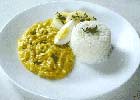
Ají de Gallina - Spicy Chicken Stew
Aji de Gallina, a spicy chicken stew, is a popular Peruvian dish especially on Lima's "cold" winter days. Aji de Gallina consists of thin chicken strips served in a savory creamy yellow sauce made of milk, bread, parmesan cheese, yellow Peruvian chilies (aji amarillo), garlic, pecans or walnuts.
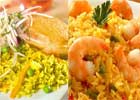
Arroz con Pollo / Arroz con Camarones - Rice with Chicken / Rice with Shrimps
Rice with chicken or sea food are very traditional and popular dishes in Peru. Ingredients and cooking techniques are very similar to the Spanish paella, so some critics say Arroz con Pollo or Arroz con Camarones is only a simple imitation of this dish combined with Asian influences; but the richly flavored rice combined with chicken or shrimps is a great example on how in the Peruvian cuisine local ingredients are merging with other influences. The result is a delicious and unique typical Peruvian dish.
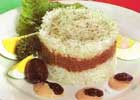
Arroz Tapado - Covered Rice
In this popular rice dish, layers of cooked rice are filled with a mixture of ground beef fried together with tomatoes, onions, garlic, black olives and hardboiled eggs.
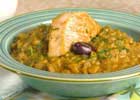
Carapulca / Carapulcra (Kalapurka) - Meat and Veggie Stew
Carapulca is one of the oldest Peruvian dishes. This stew is made of pork or chicken meat, dried potatoes, onions, different Peruvian chilies (aji), cumin, cilantro, cloves and peanuts.
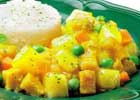
Cau Cau - Tripe Stew
The traditional Creole Cau Cau is a tripe stew served with rice. Strips of pre-cooked tripe are cooked together with onions, yellow Peruvian chilies (aji amarillo), garlic and chunks of potatoes. Before serving the stew it's sprinkled with chopped mint or hierbabuena. There are numerous variations of Cau Cau: mussel cau cau, fish cau cau, chicken cau cau...
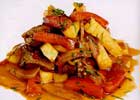
Lomo Saltado
Lomo Saltado is one of the most popular Peruvian dishes and symbolizes like no other the fusion of Peruvian ingredients with Asian techniques of preparing food. Lomo Saltado is made of sliced beef stir stir-fried with red onions, tomatoes, yellow Peruvian chilies (aji amarillo), soy sauce, vinegar and cilantro. Mixed with yellow potatoe French fries and served with rice Lomo Saltado can be found in simple restaurants and up-scale places alike.
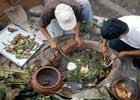
Pachamanca - "Earth Oven"
This traditional Peruvian dish (actually more a cooking method) dating back to pre-Hispanic times comes from the Andean provinces, but meanwhile conquered Lima and is found in many rustic restaurants. Hot rocks that had been heated in a fire are put into a hole in the ground creating a natural oven. According to their cooking time ingredients like potatoes, sweet potatoes, meats (beef, pork, lamb, guinea pig, alpaca, chicken marinated in spices), herbs, corn, leaves, chilies and beans are layered between more hot stones. Everything is covered with leaves and soil. After about 2 to 4 hours the "oven" is opened and an absolute delicious meal appears on your plate.
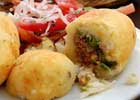
Papa Rellena - Filled Potatoes
Papa Rellena is a traditional croquette filled with a spicy ground beef mixture. Ground beef is stir-fried with onions, tomatoes, garlic, cumin, garlic and paprika. Hard boiled eggs and black olives are added. Mashed potatoes are molded around a center of the meat mixture and formed like a potatoes. The Papa Rellena then is fried in oil and served with Salsa Criolla, a sauce made of in lime juice, vinegar and oil marinated red onions, yellow Peruivan chilies (aji amarillo) and parsley.
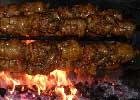
Pollo a la Brasa - Peruvian Chicken
Pollo a la Brasa, also known as Peruvian chicken, is one of the most consumed dishes in the country. Originally only seasoned with salt and cooked in charcoal today the chicken is marinated in a "secret" mixture mainly consisting of vinegar, dark beer or soy sauce, salt, pepper, chili, rosemary or cumin and paprika and then grilled in especially fabricated Pollo a la brasa ovens. Served with thick French fries and a small salad it's eaten with the fingers.

Salchipapa - Sausages and Fries
A poor man's dish that became a popular "fast food" in Peru. The word Salchipapa derives from its main ingredients: salchicha – sausage and papa – potato. Thinly sliced pan fried hot dogs or other sausages are mixed together with French fries and served with various sauces. Most often this dish is sold by street vendors or simple restaurants for a few Soles.
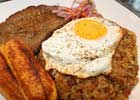
Tacu Tacu
Tacu Tacu was invented by African slaves that worked on the haciendas during Colonial times using leftovers to make a hearty and substantial meal. A mixture of rice, beans, bacon, onions and spices is formed to a thick pancake and stir-fried. It's either served as a meal for itself or with a steak, fried banana and topped with a fried egg. Tacu Tacu is also often used as a side dish for Lomo Saltado. An Afro-Peruvian specialty you shouldn't miss.
Typical Peruvian Desserts & Sweet Courses
(from www.limaeasy.com)
Peruvians love their "dulces". Relatively unknown in pre-Hispanic times Peruvian desserts are heavily influenced by its Spanish and other foreign equivalents. In Colonial times quite often expensive and unavailable ingredients used in the Spanish cuisine were replaced by typical Peruvian ones; later foreign cooking techniques were used creating unique local sweets. Even if it's difficult, always leave a little room for one of the numerous sweet (!) temptations to end your meal. You won't regret it. Below find some dessert common and popular in Lima.
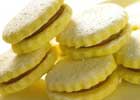
Alfajores
Alfajores have their origin in the traditional Arabic confection "alajú" found in some Spanish regions. Anyhow when the Spaniards colonized Peru most ingredients weren't available or too expensive, so adaptations to the original recipe were necessary. In Peru Alfajores consists of two layers of cookies made of flour, butter and powdered sugar filled with manjar blanco, a sweat, caramel like, sticky reduction of milk and sugar.
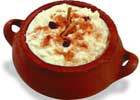
Arroz con Leche - Rice Pudding
Arroz con leche, a sweet rice pudding, is a popular Peruvian dessert. It's made of cooked rice, cinnamon, sweetened condensed milk and evaporated milk. A delicious and simple to prepare goody.
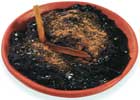
Mazamorra Morada
Mazamorra morada is a typical Limeñan dessert. Made from Peru's unique purple corn which gives Mazamorra morada not only its color but also its unique flavor, it's like a thick jelly with lots of different fresh and dried fruits.
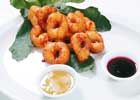
Picarones
Picarones developed in Colonial times to replace the Spanish Buñuelos. African slaves simply substituted unavailable or expensive ingredients with Peruvian ones and created an addicting, delicious sweet that even today is still quite often sold by street vendors. Picarones are kind of donuts made of a squash or pumpkin dough, deep fried and served with cane syrup called chancaca.

Pie de Limon - Lime Pie
Lemon Meringue Pie is mostly found in Anglophone countries around the world. The Peruvian version uses instead of lemons the characteristic small limes. Pie de Limon or Tarta de Limon is a very popular and extremely sweet dessert. On top of a thin pastry a lime custard or pudding is put, covered with a thick layer of meringue and baked.
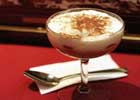
Suspiro a la Limeña
Suspiro a la Limeña is a classic Limeñan dessert. The bottom layer is made of manjar blanco, a sweat, caramel like, sticky reduction of milk and sugar, and egg yolks which is covered by a huge portion of meringue.
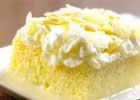
Tres Leches - Three Milks
Tres leches is a sponge or butter cake soaked in a mixture of three kinds of milk: evaporated milk, sweetened condensed milk and cream. Tres leches is a sweet and delicious, but dense and heavy dessert more like a pudding than a cake.

Turrón de Doña Pepa
Turrón de Doña Pepa is a typical dessert and treat traditionally prepared for the religious festivities of Señor de Milagros in October, but today available all year round. This extremely sweet and sticky treat consists of layers of anise cookie sticks bathed in cane syrup, called chancaca, topped with caramels and candies.
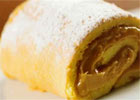
Pionono - Manjarblanco Roll
In Peru Pionono is prepared by using biscuit dough made of eggs, sugar and flour which is baked as a thin sheet. Spread with plenty of manjarblanco (a reduction of milk and sugar) and rolled up, Pionono is a delicious sweet treat for in between, as a dessert or cake. For some Pionono is heaven on earth and absolutely addictive.
The Colorful Variety of Peruvian Sauces & Dips
(from www.limaeasy.com)
Salsas, sauces or dips are an essential part of the Peruvian cuisine and a must on every table. A Peruvian menu without at least three or four different salsas is incomplete. Peruvians love their salsas and use them literally on any food. Peruvian sauces intensify or vary the unique flavors of local dishes. Nearly all salsas contain typical Peruvian ingredients like aji (chili pepper), Peruvian lime juice and local herbs making them really distinct. Just be a little bit cautious when trying a special sauce for the first time: it might be pleasantly spicy or could be incredibly hot.
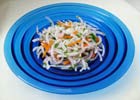
Salsa Criolla - Onion-Chili Relish
Salsa Criolla probably is the most important and most popular side dish / salsa in Peru. Prepared with red onions, aji amarillo, the juice of Peruvian limes and some freshly chopped coriander or parsley, Salsa Criolla accompanies numerous typical local dishes and just has to be on the table when enjoying a great Peruvian menu.
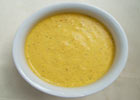
Salsa de Aji - Aji Criollo - Yellow Chili Sauce
Like Salsa Criolla, the hot and spicy Salsa de Aji is an absolute must on every table. Prepared with Peruvian yellow chili and oil, this sauce can be either pleasantly spicy with a moderate heat or extremely hot, so be careful when trying. Salsa de Aji accompanies especially Peruvian meat and fish dishes, but is great as dip for tequeños, French fries, chips and many more.
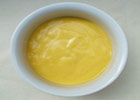
Salsa Huancaina
Salsa Huancaina is traditionally used to prepare "Papas a la Huancaina", a famous Peruvian starter. The creamy, spicy, but mild sauce is made of fresh white cheese (queso fresco), aji amarillo (Peruvian yellow chili), milk, oil, onions and Peruvian lime juice. Because Salsa Huancaina is a very versatile sauce that goes with many flavors today it's often used in other combinations as well. As dip it's great for boiled potatoes, French fries, raw and fried vegetables, tequeños and corn. It's served as sauce for pasta and accompanies meat dishes. Delicious!
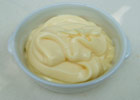
Mayonesa - Mayonnaise
Peruvian Mayonnaise might be prepared the same way as back home. But especially the use of fresh Peruvian lime juice gives the mayonesa peruana a very special flavor. Peruvians love their mayonnaise. But as they also love it hot and spicy, you find Mayonesa de Aji (chili mayonnaise) or Mayonesa de Rocoto (hot pepper mayonnaise).
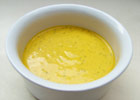
Salsa Ocopa
Originated in southern Peru in the Arequipa province, Salsa Ocopa is similar in texture to Salsa Huancaina and traditionally as well served with boiled potatoes. But its flavor is very different. Main ingredient of Salsa Ocopa is the herb Huacatay (Peruvian black mint) which gives the sauce a really unique delicious taste. Other ingredients include fresh white cheese (queso fresco), onions, aji amarillo (Peruvian yellow chili) and milk. Ocopa sauce is ideal to accompany meat dishes, potatoes, pastas and fried foods like tequeños, fried yucca or others.
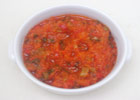
Salsa de Rocoto - Hot Pepper Sauce
Salsa de Rocoto is probably one of the most popular Peruvian sauces. This powerful hot sauce is used by Peruvians on virtually any food and an essential dip on every table. There are numerous variations of Salsa de Rocoto from medium hot to extremely hot. So be careful when trying it the first time. Main ingredient of the hot sauce are of course rocoto peppers blended with oil, Peruvian lime juice and sometimes also milk, coriander or parsley.
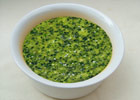
Salsa Verde de Cilantro - Green Coriander Sauce
In Peru you find numerous variations of the classical Green Sauce. Main ingredient surely is coriander which is blended with oil, Peruvian lime juice, onions, chili peppers and garlic. To make the sauce creamier often mayonnaise or even iceberg lettuce is added. Salsa Verde goes well with meat, fish, chicken and rice dishes, but is great also just with fresh French bread.
Fruit Variety in Peru
(from www.limaeasy.com)
Thanks to Peru's three main climate zones, coast, highlands and jungle, a great variety of fruits can be found in the country. Some are native to Peru, exotic or rarely known abroad others can be seen in every (super) market around the world. While you can buy bananas, apples, pears, grapes, passion fruits, papayas and many more common fruits on the Peruvian markets as well, have a look for some special and unique fruits coming originally from Peru or being important ingredients in the local cuisine.
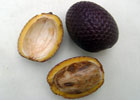
Aguaje - Moriche Palm Fruit
Moriche palm trees are native to the tropical Amazon regions of Peru. The palm fruits, which are called Aguaje in Peru, have a reddish-purple-brown tough skin with a texture similar to a pineapple. Beneath the skin is a thin layer of a firm, yellowish-orange pulp which covers a large seed. Agauje is eaten raw, in desserts or used to make juices, jams, ice-cream and an alcoholic beverage. The pulp of aguajes is extremely rich in essential fatty acids and has a high Vitamin a and C content. The oil extracted from the Moriche Palm fruit is called Buriti. In the local medicine it's used to treat burns.
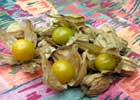
Aguaymanto - Peruvian Cherry
The Aguaymanto is also known as Tomatito Silvestre, Tomatillo, Capulí or in the US as Peruvian cherry or cape gooseberry. The fruit is native to high altitude areas in Peru where it still grows wild and has been cultivated at least since Inca times. The Aguaymanto is well hidden under a non edible paper like skin. When ripe the fruit is of a yellow-orange color. It has a sweet and sour taste and a pleasant flavor. Aguaymantos often accompany savory fish and red meat dishes. The Aguaymanto is also used to make jam, ice-cream and liqueurs. The fruit contains high levels of Vitamin A, B and C and is believed to have anti-inflammatory and antioxidant properties.
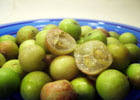
Camu Camu
The Camu Camu is native to the Peruvian Amazon Rainforest. The fruit is extremely acidic and has a taste comparable to a mixture of a sour cherry and a lime. The unique taste of Camu Camu can best be appreciated when processed in juices, jams, ice creams and yogurts. Camu Camu has an extraordinarily high content of Vitamin C. In Peru natural medicines containing Camu Camu are used as antioxidants and anti-depressant as well as for stress relieve and the treatment of flu symptoms.
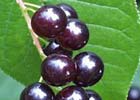
Capulin
Capulin is a cherry species. Native to Central America, Capulin has been cultivated since early times and is extensively naturalized over much of western South America. In Peru Capulin is mostly grown in subtropical and subtemperate areas as well as in the Andes. The ripe fruits are red to dark purple in color with a thin, tender skin. The pale green, juicy flesh is rather sweet with a taste of wild cherries. Capulin is mostly eaten row or stewed, made into a jam or dessert. Very refreshing are also capulin milk shakes.
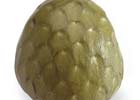
Chirimoya - Custard Apple
Chirimoya or Cherimoya, in English also known as Custard Apples, are native to the Andean highlands of Peru. The Chirimoya looks like no other fruit; it’s heart-shaped with rough-textured but thin skin which varies from a yellow-green to a dark green. The inside is white, juicy and fleshy with a creamy custard like texture and dark seeds that look like beans. Chirimoya are sweet and taste like a combination of banana, pineapple, peach and strawberry. Chirimoya can be peeled and eaten raw or used instead of an apple sauce or cooked apples for crumbles and pies.
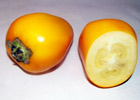
Cocona - Amazon Tomato
Cocona is a tropical citrus fruit native to the Peruvian Amazon region. It's considered to be the "Amazon Tomato" often prepared with aji and mixed with salads. Coconas are in size and shape a little bit like a bell pepper and their colors vary from yellow to red with a taste between a lime and a tomato. Cocona is often used to make sauces accompanying anticuchos or fish soups. Great are also juices, jams and dessert made of this fruit.
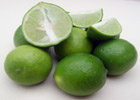
Limon Peruano - Peruvian Lime
The Peruvian lime is only around 3 to 4 cm, has a yellow to dark green skin and a light green inside. The key lime might be the closest lime variety to the Limon Peruano. But the Peruvian Lime is highly acidic, extremely sour and has an incomparable, distinct and strong flavor. Limon Peruano is one of the key ingredients in Peruvian cuisine. It's used to "cook" the raw fish in Peru's national dish Ceviche, a main ingredient in Peru's national drink Pisco Sour, part of numerous salsas and gives many typical Peruvian dishes their unique flavor.
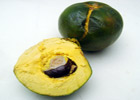
Lucuma
Lucuma is a subtropical fruit native to Peru and known as well as "the last gold of the Incas". Images of it have been found on ceramics of ancient Peruvian cultures. The round or ovoid fruits are green with a yellow to orange, fibrous flesh. Lucuma has a unique flavor of maple and sweet potato. Peruvians love their Lucuma, but it's rarely eaten raw. Instead Lucuma is a popular ingredient for ice cream in Peru and used also in cakes, puddings and desserts.
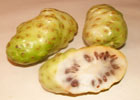
Noni - Indian Mulberry
Noni, commonly known as Indian Mulberry or Beach Mulberry isn't originally native to Peru, but finds its use quite often in dietary supplements. The fruit is more or less the same size as a potato. It has a yellow to white color. Nonis taste very bitter and smell awful. Anyhow the fruit is famous for its health benefits and used in juices, teas and natural medicines.
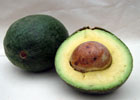
Palta - Avocado
The Avocado has a long history of cultivation in Peru. One of the oldest findings regarding Paltas in the country were made in the pre-Incan city of Chan-Chan. In Peru mainly a green type of Avocado is produced which is native to the country. Although the avocado is botanically a fruit, it's a vegetable for culinary purposes. Paltas are used in many Peruvian dishes. Popular is Palta Rellena (stuffed avocado), Sopa de Palta (avocado soup) and a dip similar to Guacamole accompanying tequeños, meat, chicken and fish dishes. Avocados are often added to salads, pureed spread on sandwiches or just eaten like they are.
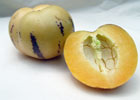
Pepino (dulce) - Sweet Pepino
The pepino or pepino dulce is native to the temperate Andean regions of Peru. The plant is not known in the wild and its origins are unclear. Pepinos come in different sizes and shapes, from small to large, round or oval. Their thin skin is of a deep yellow with purple lines. The brightly orange colored flesh is sweet, firm, very juicy and refreshing. Pepinos have a flavor of a combination of honey melons and cucumber and are very tasty. After peeling pepinos can be eaten raw and are often used in fruit salads, with your breakfast cereals or as dessert.
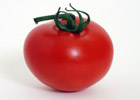
Tomate - Tomato
The tomato is native to South America and found its way to Mexico around 2000 years ago. After the Spanish colonization of the Americas the tomato was distributed around the world. Taking genetic evidence into consideration in the Peruvian highlands direct ancestors of todays tomato, a small green fruit, were harvested and consumed already in ancient times. It's assumed by many that the tomato has its origin in the Andes regions of Peru where the center of diversity seems to be situated. Although the tomato is botanically a fruit, it is a vegetable for culinary purposes, because of its flavor. While in many countries outside Peru the tomato is a key ingredient in numerous dishes, in Peru it only plays a minor part in the local cuisine. Tomatoes are often eaten raw, in salad or salsas.
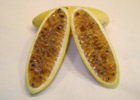
Tumbo - Banana Passion Fruit
Tumbo is part of the passion fruit family. In English it's called banana passionfruit because its size and shape resembles a small thick banana. The orange, passionfruit-like cluster of black seeds and pulp is enclosed by a firm yellow skin. Normally tumbos are quiet acidic and tart, therefore seldom eaten raw. You can best enjoy the flavor of Tumbo when processed to refreshing juices, jams and ice cream.
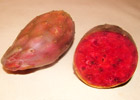
Tuna - Cactus Fruit
The Tuna also known as cactus fruit or prickly pear is cultivated in Peru since ancient times. Images of the fruit can be found on textiles of cultures like the Wari, Chimu and Incas. The fruit is oval with a thick skin, green or orange to red in color. The bright red to purple inside contains many small seeds and tastes similar to a juicy, extra sweet watermelon, when processed to jams, jellies, juices or alcoholic beverages a little bit like strawberries and figs. The tuna is believed to lower the cholesterol and blood sugar level as well as having antioxidant properties.
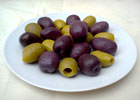
Aceitunas - Olives
Olives are native to the coastal areas of the Mediterranean. Brought to Peru by the Spanish conquerors 500 years ago, today Olives are an important ingredient in the Peruvian cuisine. The big and meaty Peruvian Aceitunas find their use in ground meat dishes like Papas Rellenas or Empanadas and as garnish on dishes like Papas a la Huancaina or Causa Limeña. They are added to salads and cream cheeses or cheese spreads. Quite often they are placed in a small bowl with some fresh bread on the table. Really delicious are olives filled with aji.
One of the first olive plantations in Lima was today's Parque El Olivar in the district of San Isidro. In 1560 Don de Rivera brought some olive plants from Spain. Unfortunately only three survived the journey which he planted on his hacienda. Soon the olive trees grew and became a focal point of his hacienda. In 1730 around 2000 olives trees were counted, at the beginning of Republican times nearly 3000. Today Parque El Olivar is still home to around 1500 olive trees.
Peru and it's "Supergrains"
(from www.limaeasy.com)
While very special "pseudograins", nuts and beans are part of the Peruvian culture and nutrition since ancient times, they were just rediscovered and gained popularity worldwide in the last few years. The international demand for Peruvian "supergrains" like Kiwicha and Quinua increases steadily, as more health-conscious people become aware of the extraordinary nutritional value of these products. Whereas peanuts and Lima Beans conquered the world centuries ago, other native Peruvian products like Sacha Inchi or Tarwi are just on the brink of doing so. And although coffee was only introduced to Peru some decades back, Peru became one of the biggest coffee producers in the world known especially for its organic produced coffee.
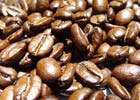
Café Peruano - Peruvian Coffee
Coffee beans originated in Africa and were introduced to Peru in the 19th century. But coffee cultivation did not become common in Peru until the mid-twentiest century. In the 1990s, coffee growing was encouraged as a replacement for coca farming by several non-governmental agencies. Today the coffee industry is one of the country's most important agricultural sectors making Peru a big player in the worldwide coffee market. Peru is noted for being a major producer of organic and fair trade coffee beans. Because of the mild nature of most coffee produced in Peru, it is used primarily for blending, French-roast and as a flavored-coffee base. However, some coffees from the northern region of Peru have a superb full body and a delicate sweetness. The Peruvian central region in particular, has gained recognition for its high quality organic coffee. And Puno coffees from the southern region are full-bodied and very citrus-like tasting. Cuzco coffee offers fruity acidity and is among the most consistently balanced Peruvian coffees.
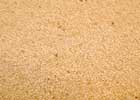
Kiwicha - Amaranth
The Kiwicha is native to the high Peruvian Andes. Also known as Amaranth, Kiwicha is an ancient crop cultivated for thousands of years by numerous cultures including the Incas. Kiwicha seeds are slightly bigger than poppy seeds and very flavorful. They are popped to produce a crunchy white nutty popcorn which is poplar and delicious as snack, cereal or breading for chicken and fish. The grain is also ground into flour, rolled into flakes, "puffed", boiled for porridge, sprinkled on salads and added to breads. The gluten free Kiwicha is very high in protein and essential amino acids and therefore often called one of Peru's "super grains". As it can be easily absorbed by the body, it's a unique energy source especially for children, sick and elderly people. Additionally regular consumption reduces blood pressure and cholesterol levels.
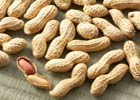
Mani - Peanut
Peanuts are believed to be of South American origin. The cultivated peanut was most probably first domesticated in the Peruvian valleys where archaeologists have found rests of mani and dated them to about 7600 years. Many pre-Columbian cultures as the Moche depicted peanuts in their art. Although peanuts are considered to be nuts culinary wise, botanically they belong to the legumes. Manis are very popular in Peru and common ingredients in the local Creole cuisine. They find their use in sweet and savory dishes alike.
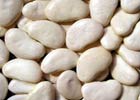
Pallar - Lima Beans
Pallar, known in English as Lima Beans or Butter Beans, are native to Central and South America. Big seeded varieties known as "Big Lima" were domesticated in the Peruvian Andean Mountains since ancient times. The pods contain oval to kidney shaped seeds. Immature beans are green, once mature creamy-white beans are common, although certain varieties feature colors such as green, red, purple, brown or black. Lima beans are a good source of dietary fiber, and a virtually fat-free source of high quality protein. Traditionally they have numerous uses in the local cuisine. Lima Beans are added to stews, soups, salads and the famous Pachamanca.
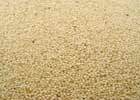
Quinua - Quinoa
Nowadays called a "supercrop", Quinua played a vital role in the Andean diet for thousands of years. The origin of Quinoa domestication appears to be located in the area around Lake Titicaca. It was an important staple food of the Incas who referred to Quinua as "mother of all grains". Small and bead-shaped, the ivory-colored quinoa cooks like rice (taking half the time of regular rice) and expands to around three times its original volume. Quinoa has a light, fluffy texture when cooked, and a mild, slightly nutty flavor. The gluten and cholesterol free Quinoa is very high in protein and considered a complete protein because it contains all eight essential amino acids. It is easy to digest and provides a rich and balanced source of vital nutrients making it an ideal food for children, sick and elderly as well as health-conscious people. Quinua is popular as breakfast cereal and as substitute for rice or couscous. It's also used in soups, salads and desserts. Quinua flour can be used in all sorts of baking. Favored by Peruvian children is popcorn made of Quinoa seeds called Kokitos.
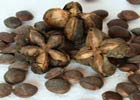
Sacha Inchi - Inca Peanut
Sacha Inchi, also known as Mani del Inca or Inca Peanut in English, is native to the Peruvian Amazon region and cultivated for centuries. The plant produces star shaped fruits which contain oval and dark brown seeds looking like flat, compact almonds. The Sacha Inchi seeds are rich in oils and proteins. The oil contains high levels of unsaturated fatty acid such as Omega 3, 6 & 9 and is rich in iodine, Vitamin A and E. It has a delicious mild nutty flavor. Traditionally Inca Peanuts are eaten as they are or roasted. The oil finds its use in numerous local dishes. The Sacha Inchi and its oil have numerous health benefits. It helps lower the blood pressure and cholesterol level, reduces blood sugar, better calcium absorption and maintains bone density, relieves symptoms of depression, improves mood and problems with hyperactivity. Additionally Sacha Inchi is widely used in the cosmetic industry. The oil restructures and protects the skin, hair and nails.
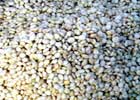
Tarwi - Andean Lupin
Tarwi is grown in the Andes since ancient times for its edible, spicy bean which was an important food for Andean cultures for centuries. The beans were found in tombs of the Nazca culture and depicted on ceramics of the Tiahuanaco. The bone-white seeds contain more than 40% protein and 20% fat, comparable in protein digestibility and nutritional value with the soybean, but until now didn't gain the popularity of it. In the Andean highlands Tarwi is incorporated in various local dishes. It's used in stews, soups, purees and sauces as well as in desserts. Tarwi Flour is used for the preparation of bread.
Peruvian Vegetables
(from www.limaeasy.com)
Peru is known around the world for its potato and corn varieties. But did you know that for example the avocado and tomato have their origin in Peru as well? And the country is home to numerous other internationally nearly unknown vegetables. Most of them have been cultivated and consumed since ancient times being an important part of the traditional Peruvian cuisine. Additionally quite a few of these ancient veggies bring remarkable properties making local dishes not only super delicious but healthy as well.
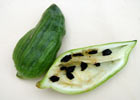
Caihua (Caigua) - Stuffing Cucumber
Caihua, known as well as Caigua or Stuffing Cucumber, was likely domesticated in the Andes and consumed by various ancient cultures. Belonging to the pumpkin family it has a teardrop to elongated shape. The outside is yellowish-green, the inside a light green and white similar to a cucumber. Caiguas are eaten raw or pickled, added to salads or stuffed with mostly spicy fillings. The Caihua has various traditional medicinal usages. Mainly it is believed to have cholesterol reducing and fat absorbing properties as well as preventing cardiac and coronary diseases.
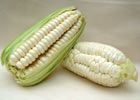
Choclo - White Corn
Peru has around 35 corn varieties. The most popular and most consumed is the Choclo, also known as maiz tierno or jilote. Choclo is a corn variety cultivated in Peru since ancient times. The seeds are bigger than the ones from the sweet corn often consumed in the US or Europe and white to creamy in color. While Choclo is one of Peru's staple foods, it never really became popular outside the country. Cooked on the cob Choclo often accompanies typical local dishes. It's also used in soups, rice dishes or pureed.
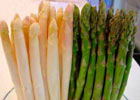
Esparrago - Asparagus
Asparagus is native to the eastern Mediterranean area, cultivated from antiquity and now grow in much of the world. It came to North America with early colonist. Only in the 1950s the cultivation of white asparagus began in the district of La Libertad in Peru; in the 1980s green asparagus was planted for exportation in the Ica region. In traditional Peruvian cuisine asparagus is immaterial. Nevertheless in just a few decades Peru became the world's largest asparagus producer and exporter. Today Peruvian asparagus is recognized worldwide for its high quality.
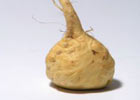
Maca
Maca is a root vegetable grown and consumed in the Andean Mountains for centuries. Traditionally it's always cooked and used in different local dishes. Maca is roasted to produce a delicious snack or dried and mixed with milk to make porridge. Maca flour is used in baking as base or flavoring. In the Andes a beer called chicha de maca is produced from the roots. Maca is believed to have hormone normalizing effects to men and women. It's very popular in Peru to increase sexual libido and fight menopause and depression symptoms as well as enhancing energy, stamina and memory.
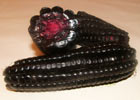
Maiz Morado - Purple Corn
Maiz morado is another corn variety cultivated in the Peruvian Andes since ancient times and once has been a staple of the Incan empire. Easy to identify by its deep purple color Maiz Morado is the main ingredient in Peru’s non alcoholic national drink, the Chicha Morada and a famous dessert, the Mazamorra Morada. Purple Corn is a great antioxidant and is believed to reduce the blood pressure and the cholesterol level, to have a positive effect on the blood vessels and to help fighting obesity and diabetes.
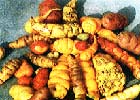
Mashua (Masho – Añu) - Mashua
Mashua, also known as añu, is a root vegetable indigenous to the Andean highlands and cultivated since ancient times. The tubers vary in size and shape. Mashua can be white or yellow; some varieties are even red or purple on the outside. Consumed raw Mashua has a peppery flavor that disappears when cooked. Mashua tubers are eaten boiled, baked, roasted, in soups and stews or soaked in molasses and honey to obtain a delicious treat. In Peruvian natural medicine Mashua is used as diuretic, anti-aphrodisiac and insecticidal. It's also believed to have antibiotic properties.
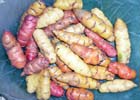
Oca
Oca is another native South American tuber grown in the high Andes since pre-Columbian times and was a staple food of various ancient cultures. The finger like tubers can be white, orange, red, pinkish or purple. Fresh ocas have a crunchy texture comparable with a carrot and a tasty sweetness. To improve its sweet flavor and culinary quality, oca is typically exposed to direct sunlight for several days prior to consumption. The roots can be prepared like potatoes or other tubers. Traditionally they are boiled, roasted, cooked in stews or used in the famous Pachamanca. Andeans steam oca and mix it with cane syrup to produce a treat called caya or make a special chuño, which is a freeze-dried potato, out of Oca called khaya. Flour made of khaya is used to make porridge and desserts. Oca is a good source of energy; its protein and fat content is low. Studies have revealed that it has antibacterial and antifungal properties.
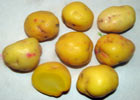
Olluco (Papa Lisa) - Ulluco
Ollucos have their origin the high plains of the Peruvian Andes and are cultivated since pre-Columbian times. Next to potatoes and corn this root vegetable was an important staple food of the Incas. They come in different shapes and sizes, but usually look like a potato. Papa Lisa, as the olluco is called as well, is orange to yellow in color with red or purple spots on the outside and has a crisp texture. Ollucos are used in various Peruvian dishes and mainly eaten cooked, mashed or baked similar to a potato. But not only are the tubers of the Ulluco plant used, but also the leaves. They are mostly added to salads. The traditional Andean way of conservation and preparation of Olluco is to make a special chuño, which is a freeze-dried potato, called llingli. Each year on the 5th of October various Andean communities in Huancavelica celebrate the "Dia del Olluquito" (the day of the ullco) by preparing famous dishes with this great root vegetable.
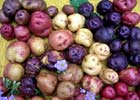
Papa - Potato
Potatoes were domesticated as early as 10,000 years ago in the High Andes of southeastern Peru and northwestern Bolivia. In the course of the centuries the Papa developed to be an important staple food and a main energy source for early Peruvian cultures. The potato was next to the corn and the quinua one of the three main staple foods of the Incas and important for feeding the Spanish conquerors. Today you can find more than 3800 varieties of potatoes in Peru. They differ in size, shape, color, skin, pulp, texture and of cause taste, but all have their place and play a vital role in the Peruvian cuisine.
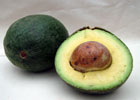
Palta - Avocado
The Avocado has a long history of cultivation in Peru. One of the oldest findings regarding Paltas in the country were made in the pre-Incan city of Chan-Chan. In Peru mainly a green type of Avocado is produced which is native to the country. Although the avocado is botanically a fruit, it's a vegetable for culinary purposes. Paltas are used in many Peruvian dishes. Popular is Palta Rellena (stuffed avocado), Sopa de Palta (avocado soup) and a dip similar to Guacamole accompanying tequeños, meat, chicken and fish dishes. Avocados are often added to salads, pureed spread on sandwiches or just eaten like it is.
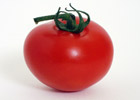
Tomate - Tomato
The tomato is native to South America and found its way to Mexico around 2000 years ago. After the Spanish colonization of the Americas the tomato was distributed around the world. Taking genetic evidence into consideration in the Peruvian highlands direct ancestors of todays tomato, a small green fruit, were harvested and consumed already in ancient times. It's assumed by many that the tomato has its origin in the Andes regions of Peru where the center of diversity seems to be situated. Although the tomato is botanically a fruit, it's a vegetable for culinary purposes, because of its flavor. While in many countries outside Peru the tomato is a key ingredient in numerous dishes, in Peru it only plays a minor part in the local cuisine. Tomatoes are often eaten raw, in salad or salsas.
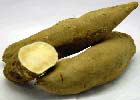
Yacon - Peruvian Ground Apple
Yacon is native to South America and grown in the Andes for centuries. Also known as Peruvian Ground Apple Yacon was consumed by ancient cultures incl. the Incas on a regular basis. The outside of these sweet tasting tubers is tan, brownish or even purple brown. Depending on the variety the inside can be white, yellow, orange or purple. The texture and flavor are described as a cross between a fresh apple and a watermelon or cucumber. Yacon is sweet, juicy and crunchy. The tubers can be eaten raw, finely sliced and mixed into salads, boiled or baked, fried as chips or prepared as a pickle. Traditionally a juice is produced from fresh Yacon which is drunk directly or concentrated to a kind of syrup that can sweeten almost anything. Yacon contains inulin, a sugar that the human body can't metabolize, making it popular as a nearly calorie free sweetener for diabetics and dieters. The fresh tubers and natural medicines made of Yacon are assumed to be an excellent antioxidant, help control the weight and lower the blood pressure. The Syrup is supposed to boost the immune system and promote digestion.
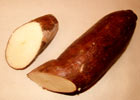
Yuca - Cassava
The yuca, a starchy tuberous root called also manioc, not to be confused with the yucca, is native to South America und was a staple food for many pre-Columbian cultures in Peru. The cassava, as yuca is known in English, was often depicted in indigenous art, like on Moche ceramics. The yuca root is long and tapered. On the outside of yucas is a rough and brown rind. The flesh can be white or yellowish. Never ever consume yuca raw. It contains cyanide and therefore must be cooked properly to detoxify it before it is eaten. This applies for the sweeter Yucas that contain fewer toxins than the bitter ones alike. The properly prepared and boiled roots have a tasty flavor and can replace potatoes in many dishes. They are served with meat dishes, made into purées and dumplings or used in soups and stews. Deep fried yuca (after boiling or steaming) is delicious and served either as replacement for fries or with typical Peruvian salsas.
Peruvian Potatoes
(from www.limaeasy.com)
While everybody agrees that the birth place of the potato is in South America, the exact place of origin is unknown and reason for the one or other open dispute between Chile and Peru. In any case there is scientific evidence that potatoes were domesticated as early as 10,000 years ago in the High Andes of southeastern Peru and northwestern Bolivia. The oldest archeological findings were made in the area of Lake Titicaca, the area around Ayacucho and in the Valley of Chulca. The word "papa" is originally Quechua and simply means tuber.
As wild potatoes taste bitter and contain small amounts of toxins, early cultures must have spend quite a bit of an effort to select the right tubers for cultivation that are more tasty and less toxic. In the course of the centuries potatoes developed to be an important staple food and a main energy source for early Peruvian cultures, the Incas and the Spanish conquerors. It is believed that sailors returning from Peru and other countries in the New World brought potatoes back with them to Spain and England around 1570. But people were suspicious of this botanical novelty and it took around 100 years until the potato was accepted. Once established in Europe, the potato soon became an important food staple and field crop. It helped reduce famines in the 17th and 18th century. Despite being first introduced outside the Andes region only four centuries ago, today potatoes have become an integral part of much of the world's cuisine.
In Peru you can find more than 3800 varieties of potatoes. They differ in size, shape, color, skin, pulp, texture and of cause in their taste, but all have their place in the Peruvian cuisine.
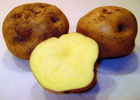
Papa Amarilla - Yellow Potato
Papa Amarilla (Yellow Potato) have, as the name suggests, yellow or butter color flesh. They have to be cooked carefully just to the point otherwise they burst open. When cooking the Papas Amarillas they get very soft and grainy. Yellow Potatoes are commonly used to make "pure de papa" (mashed potatoes) or the famous "Causa Limeña". But they are delicious also just cooked or baked in foil with different Peruvian sauces.
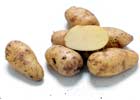
Papa Blanca - White Potato
Inside the Papas Blancas (White Potatoes) are of a pale whitish color and quite firm; however if overcooked they can get mashy. They are great for general cooking and frying and therefore probably the most consumed potato in Peru. Papas Blancas are used in all Peruvian dishes where the potatoes should stay more or less firm. They are great for French Fries, even if there are many Peruvians making them of Papas Amarillas.
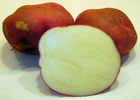
Papa Canchan
Papa Canchan, also called Papa Rosada (Pink Potato), has a pink, thin skin; the meat is of a pale whitish color like Papas Blancas, therefore probably sometimes sold under this name, but they stay much firmer when cooked and have a better flavor. Papas Canchans find a use in Peruvian stews, soups and the famous Pachamanca. It's also the most common potato variety used for Papa Rellena.
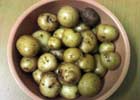
Papa Cóctel - Cocktail Potato
By now the sweet, small Cocktail Potatoes are known around the world. The texture and flavor is similar to Papa Blancas (white potatoes), but much more intense. They are great served just boiled or baked, peeled or unpeeled with sauces, but absolute delicious when used for potato salad.
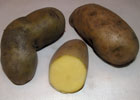
Papa Huamantanga
For most the Papa Huamantanga is the star of the potatoes. Cultivated mostly in the Peruvian Andes, today it has found its way to all good sorted mercados and supermarkets in Lima. The flesh of the Papa Huamantanga has the color of a Papa Blanca (white potato) but the texture of a Papa Amarilla (yellow potato). It finds a use in typical stews of the Peruvian highlands or is eaten just boiled.
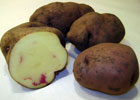
Papa Huayro
Papas Huayro have a great taste. They are very absorptive and therefore ideal as garnish for dishes with plenty of sauce, for the use in stews and soups where they incorporate the flavor or as ingredient in Causa, Papa Rellena or mashed potatoes.
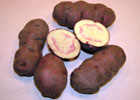
Papa Nativa
This potato is sold on Lima's markets under the name of Papa Nativa or Papa Andina even if these names describe a number of different Andean potato varieties. Anyhow in the last few years Papas Nativas became popular in Peru when a big chips producer started selling naturally bi-color native potato chips.
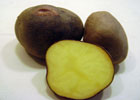
Papa Negra - Black Potato
Black Potatoes are also known under the name Papa Mariva or Papa Tomasa Negra. The skin is dark brown to black, the inside yellowish. The Papa Negra is floury, slightly sweet with a pleasant taste and finds a use in almost all Peruvian dishes: stews, soups, boiled, fried or mashed. It's an ideal potato for Papa Rellena (Peruvian Stuffed Potatoes) as it browns well.
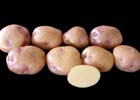
Papa Perricholi
Invented only around 30 years ago, Papa Perrichilo, named after the nickname of the Lima based stage actress Michaela Villegas, is one of the bestsellers on Lima's markets. It's similar to the Papa Blanca (white potato); sweet and watery, ideal for frying. As it doesn't change the color or get brownish after peeling the Papa Perricholi is often used in commercial kitchens, restaurants and for industrially made French fries.
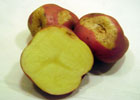
Papa Peruanita
The Papa Peruanita has a distinctive bi-color skin and an extraordinary flavor. Boiled in salt water and served peeled or even unpeeled with a little bit of butter or a light yoghurt-herb-sauce its extraordinary flavor unfolds best.
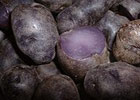
Papa Púrpura - Purple Potato
As the name suggests the skin and flesh of Papa Púrpura is of a deep purple, when cooked mostly bluish color. Today referred to by some chefs as the "Gem of the Andes", in pre-Hispanic times these potatoes were reserved for the Inca Kings. Purple potatoes can be cooked like any other potato and are very similar in taste to the "normal" ones, probably a little bit more buttery. They are best if roasted and then cut open, interesting in salads and absolutely delicious deep fried.
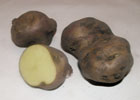
Papa Tarmeña
The skin of Papas Tarmeñas is very similar to the one of the Papa Peruanita, but the inside isn't yellow, more of a creamy color. Usually this potato is used in the famous Causa Limeña as it makes the potato mass creamy and fluffy. It's also good baked, roasted or fried and sometimes used in Lomo Saltado.
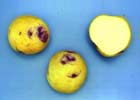
Papa Tomasa
Papa Tomasa, known also as white potatoes, aren't widely cultivated in Peru anymore and today can almost only be found in the areas of Huancavelica, Ica and Cañete. The skin is light with purple to black spots and quite tough, the flesh white. Papa Tomasa are often used as ingredient for one of Peru's most popular soups, the Sancochado and are presumably the best potatoes for Peruvian papas fritas (French fries).
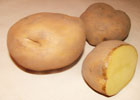
Papa Yungay
Papa Yungay are very similar to Papa Amarilla (yellow potato), but don't go off so quickly. Grown in the Peruvian Andes, they can be stored for an extended period of time without losing its flavor. Additionally Papas Yungay have varied uses in the Peruvian kitchen.
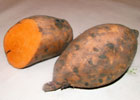
Camote - Sweet Potato
Even if the Camote is only distantly related to the potato, its English name "Sweet potato" justifies its place here. As engravings and paintings on Moche ceramics proof the Camote is part of the Peruvian cuisine for nearly two thousand years. Today over 2000 varieties are known. Camote is very popular in Peru and replaces in many dishes with its distinct orange color the "normal" potato. Sweet Potatoes often accompany Chicharrones (Peruvian fried pork rinds) and are used in the famous Pachamanca. In some regions even today the juice of red Sweet Potatoes is mixed with lime juice to dye cloth.
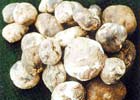
Chuño - Freeze-Dried-Potato
Chuño is a freeze-dried potato traditionally made by Quechua and Aymara communities of Peru and Bolivia. The production of Chuño dates back to pre-Inca times. After the harvest mostly small potatoes are selected and spread on flat ground. They are left in the open and freeze at night with the low temperatures of the Andes. At day they are exposed to the sun, trampled on by foot to extract the last remaining water in them and remove the skin. This process is repeated 3 to 5 nights / days. Once dried Chuño is contrary to fresh potatoes that are vulnerable to mold and rot quickly, easy to store. Kept in the typical permanently frozen underground stores in the Andes, it can be stored for years with no loss of the nutritional value. Chuño and especially Chuño Flour are used in many dishes and dessert of the Andes cuisine.
Herbs in Peru
(from www.limaeasy.com)
Next to Aji (hot peppers) aromatic herbs play a fundamental part in the Peruvian cuisine. While the Peruvian cooking and ingredients vary regionally always lots of herbs are incorporated into the dishes. Probably the most used aromatic herbs are Cilantro, Huacatay, Oregano and Basil, but there are many more that are essential for special traditional Peruvian dishes. And lots of herbs are used in Peru's natural medicine that are worth a try.
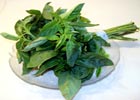
Albahaca - Basil
The use of Basil is mostly associated with the Italian cuisine. But this worldwide known herb also plays a major role in the Asian cooking. With Chinese immigrants Albahaca came to Peru. Thanks to the unique merging of Chinese and Peruvian cuisine basil found its way to Peruvian kitchens and today can be found on very market. Basil is believed to have antioxidant, anticancer, antiviral and antimicrobial properties.
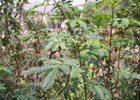
Chincho
Chincho is an aromatic herb native to Peru and was cultivated by the Incas. It belongs to the same family as Huacatay, but its flavors are less pungent. Chincho is often used in Pachamanca and in dishes from Huanucu.
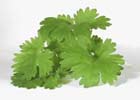
Cilantro (Culantro) - Coriander
Though Cilantro is originally not from Latin America, it has become widely popular in Peru and probably is the most used herb in Peruvian cuisine. While Coriander seeds are only occasionally used as a spice, especially the fresh leaves are used in numerous typical Peruvian dishes like Arroz con Pollo, Lomo Saltado, local stews, soups and ajis.
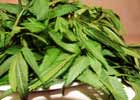
Huacatay - Peruvian Black Mint
Huacatay is a culinary herb native to Peru. Its taste and odor is like a mixture of basil, tarragon, mint and lime. Huacatay plays an important role especially in the southern Peruvian cuisine. It is used as condiment in stews, soups and Peruvian ajis and as ingredient in herb marinades for meats. Huacatay is also added to the famous Pachamanca. Its paste is used to make the popular Peruvian potato dish called ocopa. Traditionally a flavorful tea is made from Huacatay leaves which are assumed to help with colds, respiratory inflammations and stomach problems.
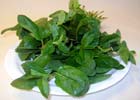
Hierba Buena (Menta) - Yerba Buena (Mint)
Hierba Buena, translated meaning the good herb refers to local species of mint, which vary from region to region. In Peru Hierba Buena is occasionally used as seasoning, but mostly for its medicinal properties. Hierba Buena teas are believed to help with digestive problems off all sort incl. diarrhea, pains and inflammations.
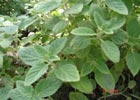
Muña - Andean Mint
Muña is an aromatic herb native to the Peruvian Andes. Mostly used as tea to treat digestive problems, it's also believed to keep bones and teeth healthy. In the Peruvian cuisine Muña has numerous uses in traditional Andean dishes and is added for example to Pachamanca.
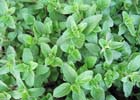
Orégano - Oregano
Although Oregano isn't originally from Latin America and almost exclusively associated with the Mediterranean cuisine, it plays a major role in Peruvian cooking. The fresh and dried leaves are used as condiment in various local dishes. Oregano is added to salads, stews, hot salsas and soups. It is used in herb marinades for meats or is just sprinkle over traditional dishes.
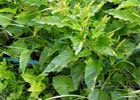
Paico - Epazote
Paico is an aromatic and medicinal herb used already in pre-Columbian times by indigenous communities in Peru. Paico is an essential ingredient in Pachamanca. The leaves are also consumed similar to vegetables in soups, the seeds are used as seasoning in beans dishes. Additionally Paico is believed to have several medicinal properties: it is suppose to help with digestive problems, gastritis, colds and asthma.
Aji Peruvian peppers
(from www.limaeasy.com)
Aji, also known as pimiento chile, originated in the Americas and are cultivated for around 7000 years. Chili Peppers might have been the first spice with which ancient Peruvians seasoned their dishes and were found in many archeological excavations. Today there are around 300 varieties of chili peppers in Peru being an essential part of the local cuisine. Below find the most commonly used ajis.
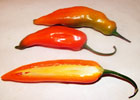
Aji Amarillo - Yellow Pepper
Aji Amarillo is the most frequently used chili in Peru and probably the most important ingredient in Peruvian cooking. The fruits start off green maturing to a deep yellowish orange. Aji Amarillo has a fruity distinguished taste and a medium to hot heat. It's mostly sold fresh as a whole chili pepper or grounded and find its use in numerous typical Peruvian dishes like the famous Papas a la Huancaina, Aji de Gallina, Causa Limeña and many more. In its dried form Aji Amarillo is called Aji Mirasol.
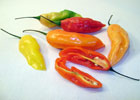
Aji Limo
Aji Limo normally is a small chili pepper that can be found in different colors like yellow, green, orange, red and purple. Take care, Aji Limo is really hot! It's usually used to season Peru's national dish, the ceviche, or other Peruvian fish and seafood dishes.
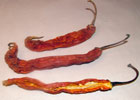
Aji Mirasol
Aji Amarillo in its dried form is called Aji Mirasol. Used as a whole pepper or grounded it has like its fresh counterpart numerous uses in the Peruvian kitchen. While Aji Mirasol is used to prepare the typical Peruvian dishes as mentioned above, it's also a great spice to season any sauce or soup giving it a really unique flavor.
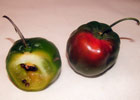
(Aji) Rocoto
Rocotos look a little like a small version of a bell pepper. But be careful, these peppers are extremely hot! Red, green or yellow on the outside they have black seats. Peruvians love their rocotos. They can be found stuffed with a delicious ground beef mixture as "Rocoto Relleno", simply grounded to use as a spice in soups and sauces, as paste or on the table of nearly every restaurant made into a powerful hot sauce used by Peruvians on virtually any food.
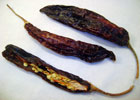
Aji Panca
Aji Panca is the second most common aji variety in Peru and frequently used in the Peruvian cuisine. It matures from green and yellow to a dark red burgundy color. Aji Panca has a berry like, fruity flavor and an aromatic, smoky taste with a mild lingering heat. It can mostly be found dried as a whole chili pepper, prepared into a paste or grounded. Today Aji Panca is often used to season seafood, rice dishes, soups and sauces.
Typical Peruvian Alcoholic and Non-Alcoholic Beverages
When talking about Peruvian drinks, the first that comes to mind is the Pisco, Peru's National Drink; Pisco Sour is a typical cocktail to welcome guests or start a Peruvian meal. But there are many other options: Peru produces some very good mostly red wines and delicious beers. And for all non-alcoholics try Chicha Morada or Peruvian Limonada and be prepared for Peru's very sweet soft drinks.
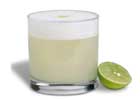
Pisco - Peru’s National Drink (Alcoholic)
Pisco is Peru's national drink and the pride and joy of every Peruvian. Pisco is a kind of brandy or aguardiente with a percentage of alcohol between 42% and 52%. It's distilled from white Muscat grapes and mostly colorless, sometimes it has a slightly amber tone. The most popular cocktail made from Pisco is Pisco sour: a delicious combination of Pisco, lime juice, egg white and syrup. An absolute must for every Peru visitor!
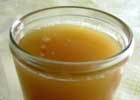
Chicha de Jora - Beer like drink from the Andes (Alcoholic)
Chicha de Jora, not to be confounded with Chicha Morada, is an alcoholic beverage from the Andes region, which already was prepared and drunken by the Incas. Chicha is traditionally obtained by the fermentation of specific maize, the jora. It's beer-like, has a pale yellowish color and a slightly sour taste. Note: the word "chicha" is used in the Andes for almost any homemade fermented drink. While it's commonly associated with maize, other grains or fruits can be used.
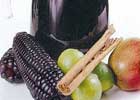
Chicha Morada (Non-Alcoholic)
Chicha Morado is a typical Peruvian non-alcoholic drink. It's prepared from a base of purple maize, known as maiz morado. While today it can be bought as bottled beverage in every supermarket, traditionally the purple maize is boiled with chunks of pineapple, quinces, cinnamon and cloves in water until the maize is soft and the liquid has taken on the deep purple color. After straining sugar a little lime juice is added. Cooled and served with small pieces of apples Chicha Morada is popular with young and old and a really delicious drink.
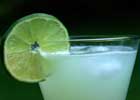
Peruvian Limonada - Peruvian Lemonade (Non-Alcoholic)
Lemonade is known around the world. The Peruvian version is made of water, the characteristic small Peruvian limes and a little bit of preferable brown sugar. Chilled and served with ice cubes it's a refreshing drink in summer.
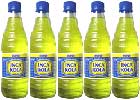
Inca Kola (Non-Alcoholic)
Inca Kola is, if we believe the advertisement, "El sabor del Peru", The flavor of Peru. Invented by an English immigrant in Rimac, Lima in 1935 Inca Kola is a bright yellow, very sweet soft drink flavored with lemon verbena, in Peru known as Hierba Luisa and tastes a little bit like bubblegum. Mainly due to Peruvian patriotism and corresponding advertisement Inca Kola soon became a cultural icon and one of the most popular soft-drinks in Peru - even beating Coca Cola in sales.
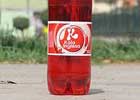
Kola Inglesa (Non-Alcoholic)
Kola Inglesa is another Peruvian soft drink. Introduced in 1912 Kola Inglesa (English Kola) has a strawberry-cherry-like flavor and a bright red color. Like Inka Kola it's very sweet, but popular with Peruvians.
